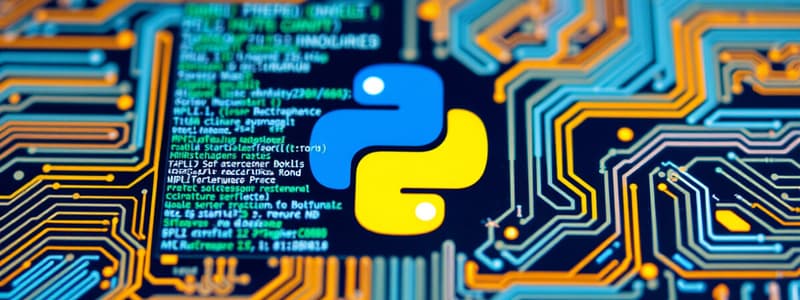Podcast
Questions and Answers
What is Python?
What is Python?
A popular programming language created by Guido van Rossum, released in 1991.
Which of the following is NOT a feature of Python?
Which of the following is NOT a feature of Python?
- Uses complex syntax (correct)
- Has a simple syntax
- Supports quick prototyping
- Works on different platforms
Python uses semicolons to complete a command.
Python uses semicolons to complete a command.
False (B)
What do comments in Python start with?
What do comments in Python start with?
When is a variable created in Python?
When is a variable created in Python?
Which of the following types can a variable name not start with?
Which of the following types can a variable name not start with?
What are the three types of case used for multi-word variable names?
What are the three types of case used for multi-word variable names?
Variable names in Python are case-sensitive.
Variable names in Python are case-sensitive.
What function is commonly used to output variables in Python?
What function is commonly used to output variables in Python?
What does the int() function in Python do?
What does the int() function in Python do?
How are strings defined in Python?
How are strings defined in Python?
Flashcards are hidden until you start studying
Study Notes
Python Overview
- Created by Guido van Rossum and released in 1991.
- Popular for web development, software development, mathematics, and system scripting.
- Compatible with multiple platforms like Windows, Mac, Linux, and Raspberry Pi.
Why Python?
- Simple, readable syntax similar to English.
- Fewer lines of code needed compared to other languages.
- Utilizes an interpreter system for immediate code execution and rapid prototyping.
- Supports procedural, object-oriented, and functional programming paradigms.
Python Syntax
- Emphasizes readability; commands are completed with new lines rather than semicolons.
- Uses indentation instead of curly brackets to define scopes for loops, functions, and classes.
Comments and Variables
- Comments initiated with
#, improving code readability and preventing execution during testing. - Variables are containers for data values and are created upon first assignment.
- No explicit type declaration is necessary; types can change dynamically.
Type Casting
- Data types can be specified using casting functions.
String Declaration
- Strings can be declared using single or double quotes interchangeably.
Variable Naming Rules
- Can be a single character or descriptive word.
- Must start with a letter or an underscore, cannot start with a number.
- Only contains alphanumeric characters and underscores.
- Case-sensitive; for example,
age,Age, andAGEare distinct variables. - Cannot use reserved Python keywords as variable names.
Multi-word Variable Naming Conventions
- Camel Case: e.g.,
myVariableName. - Pascal Case: e.g.,
MyVariableName. - Snake Case: e.g.,
my_variable_name.
Output Variables
- Use the
print()function to display variables, which can accept multiple inputs separated by commas. - The
+operator works for number addition and string concatenation.
Data Types
- Integer (int): Whole numbers without decimals, positive or negative, of unlimited length.
- Floating Point (float): Numbers containing decimals, positive or negative.
- String: Enclosed in single or double quotes; displayable through
print().
Type Conversion Functions
int(): Converts to an integer from float or string where applicable.float(): Converts to a float from integer, float, or string.str(): Converts any data type into a string format.
Studying That Suits You
Use AI to generate personalized quizzes and flashcards to suit your learning preferences.




